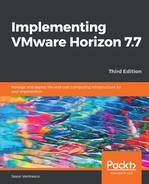A production installation of App Volumes will require the following items:
- App Volumes ISO file and license file.
- A Microsoft Active Directory domain at functional level 2003 or later.
VMware recommends that you configure Active Directory for LDAP over SSL (LDAPS) or StartTLS (LDAP over TLS) to ensure secure communications between App Volumes and Active Directory, although you can configure App Volumes without it. The Microsoft Developer post entitled Step-by-Step Guide to Setup LDAPS on Windows Server outlines how to configure LDAPS (https://blogs.msdn.microsoft.com/microsoftrservertigerteam/2017/04/10/step-by-step-guide-to-setup-ldaps-on-windows-server/).
- A Microsoft SQL Server 2008R2 SP2 or later database and account with database owner permissions:
- Consult the App Volumes documentation (https://docs.vmware.com/en/VMware-App-Volumes/index.html) for a complete list of supported SQL versions and patch levels
- SQL Server Clustered Instances and Server Mirroring are also supported
- In this chapter, we will use a database named RTP_AppVolumes1 and a SQL user named svc_appvolumes
- vSphere 5.5.x or newer, including vCenter.
- Static IP addresses and pre-created DNS entries for each of the App Volumes Manager servers.
- App Volumes Manager-supported OSes and other requirements:
- Windows 2008 R2 or newer
- 4 GB RAM, 4 vCPU, 1 GB disk space
- .NET 3.5 Framework
- Accessible over TCP ports 80, 443, and 5985
- App Volumes Agent-supported OSes and hardware and configuration requirements:
- Windows 7 SP1 or newer, excluding Vista (for use as a desktop OS, hot fix 3033929 required)
- Windows 2008 R2 or newer (for use as an RDS server or as a desktop OS):
- For desktops, disable the Control Read and Write Access to Removable Devices or Media group policy setting
- 1 GB RAM, 1 vCPU, 5 MB disk space
- A provisioning computer, deployed as a virtual machine, running the same OS as the App Volumes clients; multiple provisioning computers will be required if you use more than one desktop or Windows RDS OS version.
- Two AD user accounts, or one account that has been granted both sets of the following permissions:
- Read access to the Active Directory
- vCenter permissions, as outlined in the next section of this chapter, entitled vCenter permissions
- In the examples provided, we will use a single account named svc-appvolumes
- One AD group who you will grant administrative access to App Volumes. In the examples provided, we will use a group named AppVolumes_Admins.
- One AD group to assign AppStacks to. In the examples provided, we will use a group named AppVolumes_NotepadPlus.
- One AD group to create writable volumes for. In the examples provided, we will use a group named AppVolumes_WV.
- One vSphere datastore per 1,000 writable volumes. The default Writable Volume template is 10 GB in size, so these volumes could require as much as 10 TB of space each.
- One vSphere datastore for every 2,000 clients who will attach to AppStacks. The size of these AppStack datastores will vary based on the number of AppStacks that will be created.
The figures provided with regard to the number of App Volumes Manager appliances, and the number of users per vSphere datastore, is subject to change. Consult the VMware App Volumes product documentation (https://docs.vmware.com/en/VMware-App-Volumes/index.html) and other resources listed throughout this chapter for updated information on the recommended infrastructure configuration.
While not explicitly required, we will be using AD security groups to entitle users to AppStacks and Writable Volumes. It is possible to assign each directly to users using the same methods that will be demonstrated in this chapter.
